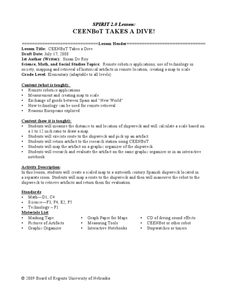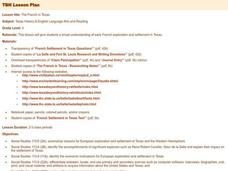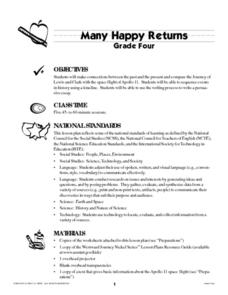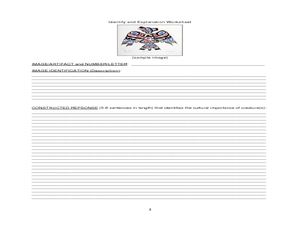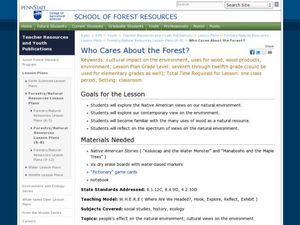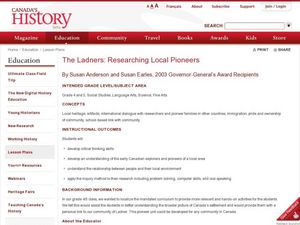Curated OER
Death On Board La Belle: Finding Clues from Old Bones
Students practice analyzing skeletal remains for clues by using the Internet. In this scientific investigation lesson, students research the La Belle shipwreck using the Internet and written materials, later completing a Skeletal Report...
Curated OER
CEENBoT Takes a Dive
Students create a map to scale using technology. For this algebra lesson, students navigate through a shipwreck to perform rescues. They use he CEENBoT program to perform the different tasks.
Curated OER
Give Me Liberty
Students define the term "liberty." They explore the concept of liberty in our nation's history and how it is reflected throughout our rich culture. Students connect the office of the presidency to our nations' development and its place...
Curated OER
The French in Texas
Fourth graders gain a broad understanding of early French exploration and settlement in Texas. They access websites imbedded in this plan. Using their notes, 4th graders work alone or with a partner to create an illustrated journal with...
Curated OER
ourney Through Time: Art Tells the History of Nebraska
Fourth graders discuss early Nebraskan history. They view and discuss the painting "Sodhouse Family." Students are directed to the artistic elements of the painting, such as the horizon line. They follow a prescribed procedure to create...
Curated OER
Digital Storytelling
Students write a personal narrative and convert the story into digital format. In this digital storytelling lesson, students write a personal narrative, record the story, create images for the story, add animations or transitions, and...
Curated OER
Women's Votes, Women's Voices
Students investigate Women's Suffrage by analyzing images from the past. In this equal rights lesson, students read biographical work about Emma Smith DeVoe, an activist who fought for women's rights. Students view a comic style...
Curated OER
Ecoregions of Texas
Seventh graders discuss why hunter-gatherers might have favored certain areas in which to live. In pairs, they research specific regions to examine in depth. Students present their eco-region vegetation findings (in this case Central...
Curated OER
Mythology and Ancient Civilizations
Third graders examine ancient world civilizations and the mythologies they created to explain natural phenomena, as well as the writers and poets who wrote about the mythologies.
Curated OER
Which Came First?
Pupils examine the significance of the Louisiana Purchase and the journey of Lewis and Clark. They sequence events that occurred on the journey of Lewis and Clark.
Curated OER
Many Happy Returns
Students compare the journey of Lewis and Clark with the space flight of Apollo 11. Students sequence events using a timeline. Students write a persuasive essay trying to persuade the people of the US to support space exploration.
Curated OER
Stories Behind Pacific Northwest First Nations' Images
Students investigate Canadian culture by examining mascots of the 2010 Olympics. In this Canadian history lesson, students read a Vancouver Olympics guide to identify three Canadian mascots and their importance to the First Nations...
Curated OER
Death at Jamestown
High schoolers use primary source documents to develop a theory about what happened at Jamestown. They use the internet to gather information about the colony. They evaluate the theory of Dr. Hancock as well.
Curated OER
The Anasazi
Students investigate and determine the origins of the ancient Anasazi who inhabited present-day Utah and the Four-Corners-Region.
Curated OER
Digging Deeper in Mission San Saba
Seventh graders explain Spanish motives for establishing Mission San Sab?? and the reasons for the mission's failure. This lesson should be used when students already have an understanding of the Spanish mission-presidio system in Texas.
Curated OER
War In Iraq Comparison
Fifth graders use the internet to research the Silver Star given to those who served in Operation Iraqi Freedom. Using the information, they write a short report on one of the recipients of the Silver Star. In groups, they visit a...
Curated OER
To Dig or Not to Dig: The Stadium Showdown
Students examine an ethical public dilemma. In this cultural resource instructional activity, students role play to examine their personal beliefs regarding the protection of cultural resources. They evaluate possible actions they can...
Curated OER
Who Cares About the Forest?
Students explore the natural environment and people's views, in particular the Native Americans. In this environment lesson students discover the many uses of wood as it pertains to our natural resources.
Curated OER
How Do They Know That
Young scholars explore methods for reconstructing the past. In this forest succession instructional activity, students examine forest succession and how to read the land in order to predict patterns of change. Young scholars will visit a...
Curated OER
Colonial America
Students discover the history of Colonial America by creating a class presentation. In this U.S. History lesson, students utilize the Internet to research one of 20 topics in which they will create a PowerPoint or other type of...
Curated OER
The Underground Railroad and The Fugitive Slave Law of 1850
Students discover racism and slavery by completing a role playing activity. In this U.S. history instructional activity, students analyze documents from the Civil War era and describe the Fugitive Slave Law. Students view a video on...
Curated OER
The Ladners: Researching Local Pioneers
Students research local Canadian explorers and write a report on them. In this research lesson plan, students look at local heritage and relationships that came out of those explorers.
Curated OER
Hatching Chickens
Students observe chicks hatching from eggs. In this science lesson plan, students view a video to develop an understanding of the proper care and needs of eggs and live animals. This is a great precursor activity for hatching eggs in class.
Curated OER
UMNH: Cultural Clutter - Tales In The Trash
Fourth graders list three or more types of evidence of prehistoric cultures that encouraged archaeologists to investigate the marshes around the Great Salt Lake. They also explain why it is important not to disturb archaeological remains.



